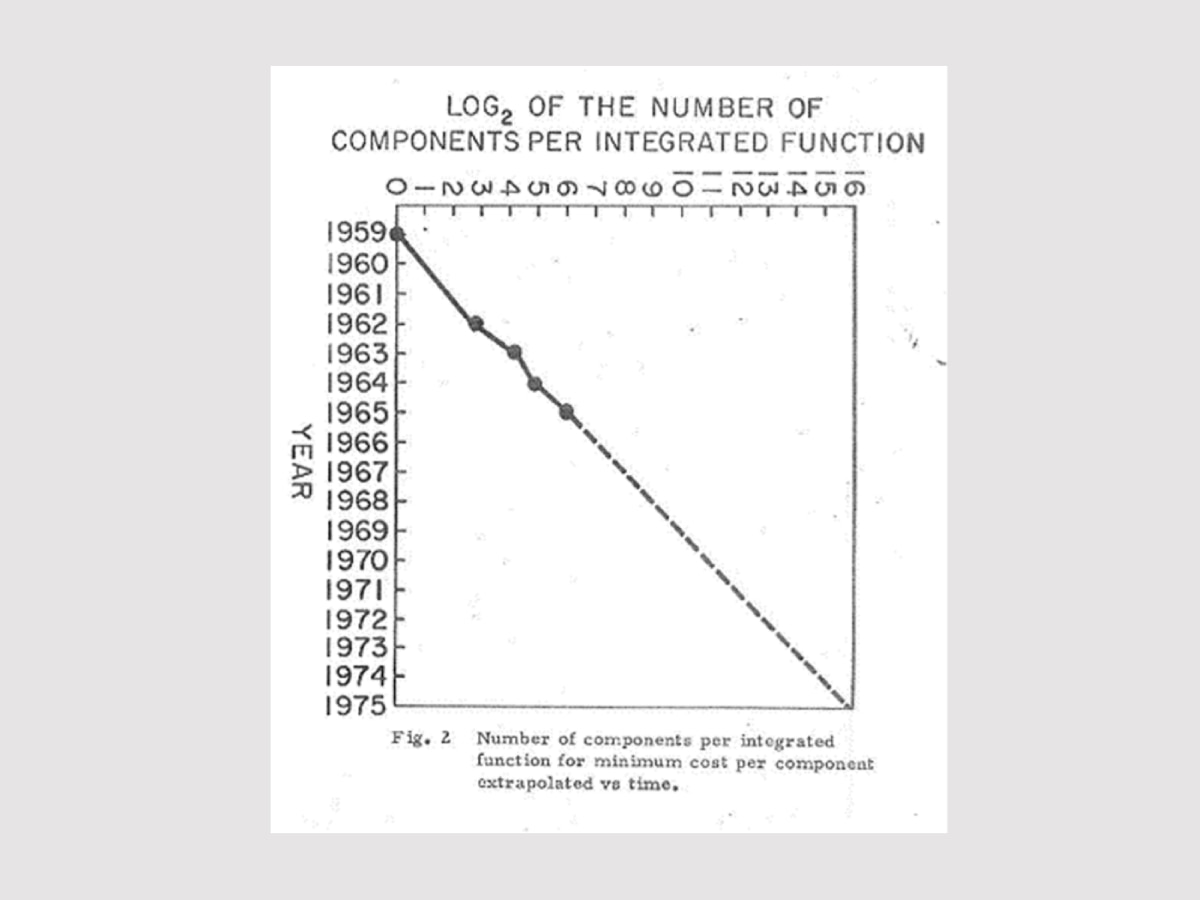Moore’s Law Is Said To Be Dying. Will That Mark The End For Chip Manufacturers?
Accepting the death of Moore’s law will simply mean the end of “innovation” as we know it.

Moore’s law — an over-50-year-old postulation that held true for decades — implies that gadgets that rely on computing power will become smaller, faster, and cheaper with time. It suggested, with surprising accuracy, that transistors on integrated circuits (ICs) will only get more efficient with each passing year. Now, there are several experts and chipmakers who have emphatically stated that Moore’s Law is dying. This means that new chip-driven tech is claimed to be neither cheaper nor better when compared to older models. If this is indeed true, does this mean that chipmakers could be out of a job soon? Or is there a deeper call to action here? Let’s find out.
How Well Did Moore’s Law Hold True Over The Years?
First things first, let us understand what Moore’s law exactly is.
In 1965, Intel co-founder Gordon E. Moore observed that the number of transistors in a dense IC will continue to double every two years. Moore predicted that this trend will continue for at least a decade, i.e. till 1975. Fast forward to 2022, when entire computers are sophistically fitted within the palm of our hands (smartphones, tablets) or even on other parts of our body (AR/VR goggles for the eyes, neural link chips for the brain, and so on). It’s easy to see why chipmakers consider Moore’s law as the golden driving factor for product innovation.
For those unaware, a transistor is one of the basic building blocks of modern technology. It is a semiconductor that helps switch or amplify electric signals and powers as needed. An IC, on the other hand, is a chip on which millions of miniature transistors, capacitors, diodes, and resistors are fabricated. To put things very simply, more transistors on an IC means that the chip is capable of doing more tasks with ease, thereby bringing about the advancement of technology as a whole.
While more of an empirical production model than an outright law, Moore’s law managed to hold strong to this day. Back in 1971, metal–oxide–semiconductor field-effect transistor (MOSFET) scaling model saw chips being manufactured on the 10 µm (micrometre) model. In 1974, the scaling went down to 6 µm and then to 3 µm in 1977.

Chipmakers would eventually develop nm (nanometre) architecture process, starting with 800 nm in 1987, 600 nm in 1990, and so on.
In 2020, the 5 nm process came into existence. In 2022, 3 nm was hailed as the next milestone. Looking to future, 2 nm architecture is expected to become a reality by 2024.
Chipmakers are constantly bringing about more and more R&D gems to make ICs more capable and of course, much smaller. Different design technology and architecture are being employed to make these possible.
For example, Samsung uses the gate-all-around field-effect transistor (GAAFET) technology to design its 3 nm chips. It also plans to use multi-bridge channel field-effect transistor (MBCFET) in its designs for even better output.
Leading chipmakers TSMC and Intel, on the other hand, use refined fin field-effect transistor (FinFET) technology to design their chips.
And all these innovations in design and production were simply made possible by Moore’s law, as companies strived to keep the law alive and well through their creations.
"Moore’s Law is and always has been driven by innovation," said Dr Ann B Kelleher, the technology development general manager at Intel, who is in charge of the company's 7 nm and 5 nm process technology. “The rate of digitalization of the world surged over the past two years, triggered by the COVID-19 pandemic, and this enhanced transition was enabled by the semiconductor industry and its innovation,” Kelleher wrote in a blog post.
ALSO READ: 5G Phones Hold 32 Percent Market Share In India, Samsung Top Selling Brand: Counterpoint
‘Moore’s Law Only Stops When Innovation Stops’
If we consider Kelleher’s point on innovation, accepting the death of Moore’s law will simply mean the end of “innovation” as we know it.
“Moore’s law only stops when innovation stops,” Kelleher said. “When we consider all the various process and advanced packaging innovations, there are numerous options available to continue to double the number of transistors per device at the cadence demanded by our customers.”
Intel is currently focussed on delivering nearly 1 trillion transistors in a single device by 2030. To put that number into perspective, it should be noted that 3 billion transistors were already placed in a chip back in 2012. Considering that, Moore’s law of adding double transistors on a chip every two years is still very much a reality, however, it has slowed down drastically. There are several macroeconomic issues that impacted the growth, from the COVID-induced pandemic to the ongoing Russia-Ukraine war, to mention just a few.
Kelleher doesn’t seem to be deterred though, relying heavily on technological innovation going steady in years to come. “As we look forward to innovative technologies such as High NA, RibbonFET, PowerVia, Foveros Omni and Direct, and others, we see no end to innovation and therefore no end to Moore’s law,” Kelleher said.
Kellher’s optimism, however, appears to be just one side of the coin.
Cheaper Chips ‘A Story Of The Past’
“Computing is a not a chip problem, it’s a software and chip problem,” said NVIDIA president and CEO Jensen Huang while explaining the rising price of gaming cards at the company's GTC AI conference for developers in September 2022.
“Moore’s law is dead,” Huang said. “And the ability for Moore’s law to deliver twice the performance at the same cost, or at the same performance, half the cost, every year and a half, is over. It’s completely over, and so the idea that a chip is going to go down in cost over time, unfortunately, is a story of the past.”
Intel CEO Pat Gelsinger, on the other hand, continues to remain hopeful. “Moore’s law is not dead. We will continue to be the stewards of Moore’s law,” Gelsinger said at the 2022 Intel Innovation event in September as he announced a new GPU, the Arc A770, which was priced at a whopping $329. Leading GPU makers AMD and NVIDIA both continue offering performance-class GPUs that are priced between $300 and $400.
In 2012, NVIDIA’s GPU offerings, such as the then-top-of-the-line GTX 650 Ti, was priced below $200. In 2022, the RTX 2060 is priced just below $400, marking a nearly 100 percent price appreciation within a decade.
So, despite the Intel chief’s hopeful outlook, it appears that while chip technology continues to grow, it is the customers who have to shell out more bucks in the end.
For now, chipmakers are on the lookout for cheaper avenues to continue bringing technological innovation at affordable prices.
ALSO READ: Govt Likely To Announce PLI Scheme For More Sectors: Report
Can Make-In-India Make It Happen?
India’s push for home-manufactured tech products could indeed help bring down costs, if experts and industry leaders are to be believed.
“Today, a laptop costs Rs 1 lakh, and once the glass as well as the semiconductor chip are available, the same can be priced at Rs 40,000 or less,” Vedanta Chairman Anil Agarwal said in September last year, claiming that ‘made in India’ semiconductors could drastically reduce the price of finished products.
“The glass that is currently produced in Taiwan and Korea will very soon be manufactured in India too,” Agarwal added.
As per IT Minister Ashwini Vaishnaw, India has around 24,000 design engineers working within the country. While that’s a solid, dependable workforce, India still lacks an end-to-end manufacturing base, which makes the country rely heavily on US, Taiwan, and Japan to meet its semiconductor demands.
In a first, India in December 2021 approved a Rs 76,000-crore production-linked incentive (PLI) scheme to help boost semiconductor and display manufacturing within the country.
The Ministry of Electronics and Information Technology (MeitY) is also reportedly working on an incentive scheme to promote the manufacturing of high-end components for phones, PCs, and servers, with a possible financial outlay of up to Rs 12,000 crores.
A $3-billion chip-making plant, India’s first of its kind, is being developed by the international semiconductor consortium ISMC in Karnataka. Vedanta and Taiwan-based Foxconn is also looking to open their own fabrication plants in Gujarat. Singapore-based IGSS Ventures has also proposed a $3.2-billion semiconductor park in Tamil Nadu.
With the upcoming Union Budget looming on the horizon, India’s electronics industry has written to the Centre, asking for an extension of the manufacturing scheme for semiconductors and electronic components (Specs). The industry has also requested for an increase in outlay from Rs 3,000 crores to Rs 10,000 crores.
It remains to be seen what the Centre decides.








































